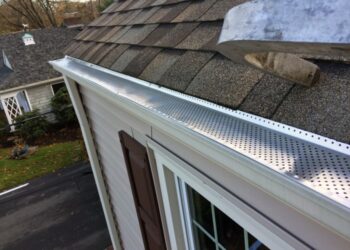Dive into the realm of siding installation services where different materials, processes, costs, and maintenance play a crucial role in transforming properties. Let’s unravel the secrets behind the perfect siding installation journey.
In this comprehensive guide, we will explore the various types of siding materials, the intricate installation process, budgeting considerations, and the key to maintaining the longevity of your siding.
Types of Siding Materials
When it comes to siding materials for installations, there are several options available, each with its own set of pros and cons. Understanding the different types can help you make an informed decision based on your specific needs and preferences.
Vinyl Siding
Vinyl siding is one of the most popular choices due to its affordability, low maintenance, and versatility in terms of colors and styles. It is durable, resistant to rot and insects, and easy to clean. However, it may crack or fade over time, and extreme weather conditions can affect its performance.
Vinyl siding is best suited for residential homes looking for a cost-effective and low-maintenance option.
Fiber Cement Siding
Fiber cement siding is a durable and long-lasting option that can mimic the look of wood, stucco, or masonry. It is resistant to fire, rot, and insects, and requires minimal maintenance. However, it is heavier than other siding materials, making installation more labor-intensive.
Fiber cement siding is ideal for homeowners seeking a high-end, low-maintenance option with a natural appearance.
Wood Siding
Wood siding offers a classic and timeless look that can enhance the aesthetic appeal of a home. It is natural, environmentally friendly, and can be easily painted or stained to match the desired color scheme. However, wood siding requires regular maintenance, such as painting or sealing, to protect against moisture and pests.
Wood siding is best suited for homeowners looking for a traditional and customizable option with a warm and rustic feel.
Aluminum Siding
Aluminum siding is lightweight, durable, and resistant to rust and corrosion. It is easy to install and comes in a variety of colors and finishes. However, aluminum siding can dent easily and may require repainting over time. Aluminum siding is suitable for homeowners looking for a cost-effective and low-maintenance option that offers good insulation properties.
Brick Siding
Brick siding provides a strong and durable exterior that offers excellent insulation and soundproofing properties. It is low maintenance, fire-resistant, and can last for decades without needing replacement. However, brick siding is expensive to install and repair, and the weight of the material may require additional structural support.
Brick siding is ideal for homeowners looking for a high-end and long-lasting option with a classic and elegant appearance.
Siding Installation Process
Installing siding on a property is a multi-step process that requires precision and the right tools. Here is a detailed breakdown of the siding installation process:
Preparation and Planning
Before starting the installation, it is crucial to prepare the area by removing any existing siding, cleaning the surface, and ensuring proper insulation. Planning the layout and design of the siding is also essential to ensure a smooth installation process.
Tools and Equipment
To successfully install siding, you will need a range of tools and equipment, including:
- Vinyl cutting tools
- Level
- Tape measure
- Nail gun
- Siding clips
- J-channel
Installation Process
The actual installation process involves:
- Start by installing the starter strip at the bottom of the wall.
- Place the first siding panel at a corner, ensuring it is level.
- Continue installing panels, making sure to leave space for expansion.
- Secure the panels with nails or clips, following the manufacturer’s instructions.
- Finish by installing the top trim and corner pieces for a polished look.
Common Challenges and Solutions
During the siding installation process, some common challenges may arise, such as:
- Uneven walls affecting alignment: Use a level and adjust as needed.
- Weather conditions impacting installation: Work during favorable weather or make accommodations.
- Improper insulation causing moisture issues: Ensure proper insulation before installing siding.
By being aware of these challenges and having solutions in place, you can overcome them and successfully complete the siding installation on your property.
Cost Factors and Budgeting
When it comes to siding installation services, understanding the cost factors involved and budgeting effectively can help you manage your expenses and get the best value for your money.
Breakdown of Cost Factors
- Material Costs: The type of siding material you choose will greatly impact the overall cost of the project. Vinyl siding tends to be more affordable compared to options like wood or fiber cement.
- Labor Costs: The complexity of the installation, the size of your home, and the time required to complete the project will all affect the labor costs involved.
- Permits and Fees: Depending on your location, you may need to obtain permits for the installation, which can add to the overall cost.
- Additional Services: If any repairs or preparations need to be done before the siding installation, these additional services will also contribute to the total cost.
Tips for Effective Budgeting
- Get Multiple Quotes: To ensure you are getting a fair price, it’s recommended to obtain quotes from multiple siding installation companies.
- Set a Realistic Budget: Consider your financial situation and set a budget that allows for quality materials and professional installation without overspending.
- Plan for Contingencies: It’s wise to set aside some extra funds for unexpected expenses or changes during the project.
Reducing Costs Without Compromising Quality
- Consider Different Materials: Explore different siding materials to find one that fits your budget while still offering durability and aesthetics.
- Opt for Standard Sizes: Custom sizes and shapes can increase costs, so choosing standard sizes for your siding can help reduce expenses.
- DIY Preparation: If you are capable, consider handling any necessary repairs or preparations yourself to save on labor costs.
Maintenance and Longevity
Regular maintenance is crucial for ensuring the longevity and durability of your siding after installation. By properly caring for your siding, you can prevent damage, extend its lifespan, and maintain the overall appearance of your home.
Proper Care for Different Types of Siding Materials
- Vinyl Siding: Wash annually with a mixture of soap and water to remove dirt and grime. Inspect for any cracks or damage that may need repair.
- Fiber Cement Siding: Clean with a mild detergent and water, avoiding abrasive materials that could scratch the surface. Check for any signs of moisture penetration or discoloration.
- Wood Siding: Regularly paint or stain to protect against moisture and UV damage. Inspect for rot, mold, or insect infestations that may require treatment.
- Aluminum Siding: Wash with a solution of water and mild detergent, avoiding harsh chemicals that could damage the finish. Check for dents or scratches that may need to be addressed.
Expected Longevity and Lifespan Extension
- Vinyl Siding: Expected to last 20-40 years with proper maintenance. To extend its lifespan, regularly clean and inspect for any signs of damage.
- Fiber Cement Siding: Can last 30-50 years or more with proper care. Ensure regular cleaning and inspections to identify any issues early on.
- Wood Siding: Depending on the type of wood and maintenance, it can last 20-100 years. Staying on top of painting, staining, and repairs can help prolong its lifespan.
- Aluminum Siding: Expected to last 20-40 years with proper maintenance. Keep an eye out for any damage and address it promptly to avoid corrosion.
Summary
As we conclude our journey through the world of siding installation services, it’s clear that attention to detail, proper planning, and maintenance are the cornerstones of a successful project. Embrace the beauty and durability of well-installed siding for your property.
Common Queries
How do I choose the right siding material for my property?
Consider factors like durability, cost, and aesthetics to determine the best siding material for your specific needs.
What tools are essential for a successful siding installation?
Tools like a hammer, nails, level, saw, and tape measure are crucial for a smooth siding installation process.
How can I maintain the longevity of my siding?
Regularly clean your siding, inspect for damage, and make repairs promptly to ensure its longevity.





